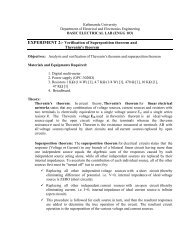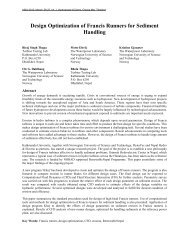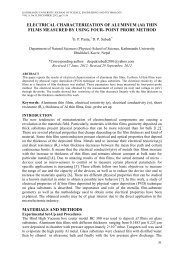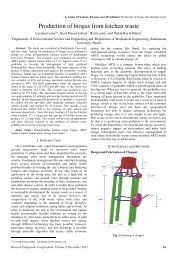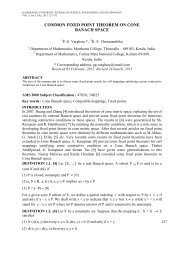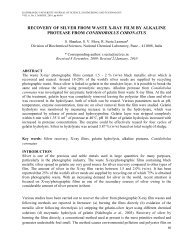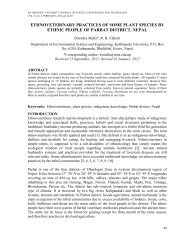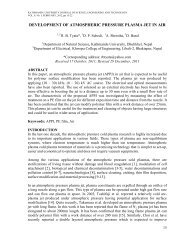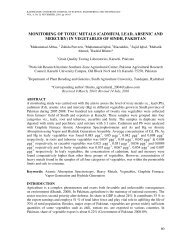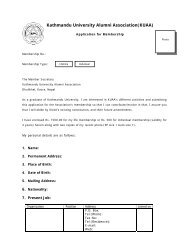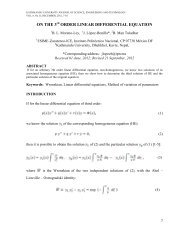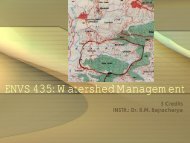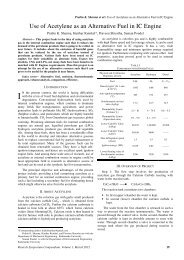ethnobotany of moraceae in meghalaya north- east india
ethnobotany of moraceae in meghalaya north- east india
ethnobotany of moraceae in meghalaya north- east india
You also want an ePaper? Increase the reach of your titles
YUMPU automatically turns print PDFs into web optimized ePapers that Google loves.
KATHMANDU UNIVERSITY JOURNAL OF SCIENCE, ENGINEERING AND TECHNOLOGYVOL. 6, No. I, MARCH, 2010, pp 5-10India Eastern Circle, Shillong. Voucher specimens are deposited <strong>in</strong> the Herbarium <strong>of</strong> Department <strong>of</strong>Botany <strong>in</strong> St. Anthony’s College, Shillong.ENUMERATIONThe species are arranged alphabetically, each followed by local name <strong>in</strong> Khasi (K) , Garo (G) orJa<strong>in</strong>tia (J), locality, voucher specimen number and salient features. This is appended with a brief note<strong>in</strong> the parts <strong>of</strong> the plants used and the mode <strong>of</strong> utilization. Some <strong>of</strong> the species are illustrated.Artocarpus chaplasha Roxb., Bol- Sram (G), Dieng-soh-ram (K), Burnihat, 0173, l<strong>of</strong>ty deciduoustree with spread<strong>in</strong>g crowns, fruits are eaten raw or cooked, leaves are used for mak<strong>in</strong>g dishes, woodsfor mak<strong>in</strong>g s<strong>of</strong>t timber.A. gomezianus Wall., Dieng-soh-ram (K), Umsaw, 0008, largedeciduous tree with oval crown andbrownish grey bark, fruits are eaten cooked, leaves and twigs lopped for fodder, woods used fortimber and fuelwood.A. heterophyllus Lamk., Dieng-sophan (K), Burnihat, 0132, large evergreen trees with grey bark anddense sub-orbicular crown, immature fruits are eaten cooked or pickled, ripe fruits are eaten raw,short twigs with leaves are lopped for fodder, woods used for good quality timber, children use latexfrom fruits to make sticky gum for hunt<strong>in</strong>g birds.Ficus auriculata Lour., Thebol (G), Mawiong, 0212, medium sized deciduous tree, fruits are eatenraw, leaves are lopped for highly palatable fodder.F. benghalensis L., Gonak (G), Jorabat, 0057, large evergreen tree with brownish grey bark, fruitsare eaten by children, twigs heavily lopped for fodder throughout the lean period dur<strong>in</strong>g October toMay.F. bhotanica K<strong>in</strong>g ex Hook.f., Soh-syrme-blang (K), Nongsto<strong>in</strong>, 0172, shrubs or small tree withsmooth grey bark, fruits are eaten raw, long shoots with leaves are lopped for fodder.F. fulva Re<strong>in</strong>wardt, Dieng-surisoh (K), Umsh<strong>in</strong>g, 0019, 0027, erect shrub with dense hairs andyellowish grey bark, fruits are eaten raw, long shoots are lopped for palatable fodder.F. gasparr<strong>in</strong>iana Miq., Soh-syrmeh-blang (K), Nongsto<strong>in</strong>, 0088, shrubs with greenish bark, fruitsare eaten raw, leaves are lopped for fodder.F. hirta Vahl., Dieng-soh-rompian (K), Mawiong, 0056, shrub or small tree with warty bark, ripefruits are eaten raw, long shoots with leaves are heavily lopped for palatable fodder.F. hispida L., Dieng-lapong (K), Jorabat, 0135, medium sized tree with ovoid crown, fruits are eatencooked or pickled, leaves are used for mak<strong>in</strong>g dishes and twigs are lopped for fodder.F. lamponga Miq. Dieng-thalliang (K), Bol-khan-thap(G), Umsh<strong>in</strong>g, 0133, middle sized tree withbrownish grey bark, fruits are eaten, short twigs with leaves are heavily lopped for fodder dur<strong>in</strong>gFebruary to May, fibers extracted from the bark.6
KATHMANDU UNIVERSITY JOURNAL OF SCIENCE, ENGINEERING AND TECHNOLOGYVOL. 6, No. I, MARCH, 2010, pp 5-10F. neriifolia J.E. Sm., Soh-rom-blang (J), Jara<strong>in</strong>, 0106, middle sized deciduous tree, fruits are eatenraw or cooked, newly sprouted twigs with leaves are lopped dur<strong>in</strong>g April to May for good qualityfodder.F. oligodon Miq., Ka-jiri-sim (J), Latrymbai, 0216, ripe fruits are eaten, leaves are used for mak<strong>in</strong>gdishes, bark for extraction og fibers.F. religiosa L., Phrap-thibrong (G), Burnihat, 0012, large deciduous tree with yellowish grey bark,ripe purple fruits are eaten, newly sprouted twigs with leaves heavily lopped for fodder dur<strong>in</strong>g Aprilto May.F. semicordata J.E. Sm., Am<strong>in</strong>sep (G), Dieng-duit-lasas (K), Sohrarim,0221, small evergreen treewith blakish grey bark, ripe fruits are eaten, leaves are slashed for fodder, bark is used for fiber.F. sub<strong>in</strong>cisa Buch.-Ham., Samch-blang (K), Mawiong, 0063, erect evergreen shrub, raw fruits areeaten deliciously, long shoots with leaves are slashed dur<strong>in</strong>g December to May for palatable fodder.F. virens Ait., Dieng-soh-poklao (K), Dieng-chiri (J), Kyrdemkulai, 0010, medium sized deciduoustre with whitish grey bark and has lax ovoid crown, yellowish ripe fruits are eaten by children, leafbuds along with stipules are eaten as vegetables or pickle, newly sprouted shoots with leaves areheavily lopped for supplementary fodder from March to May.Morus australis Poir., Soh-lyngdykhur (K), Kyntonmasar, 0238, middle sized deciduous tree withtan brown bark, ripe blackish fruits are eaten and also marketed, silkworms are reared on maturedleaves, newly flushed twigs with leaves are lopped for fodder.M. serrata Roxb., Dieng-soh-tungkhar (K), Mawlai, 0075, large deciduous tree with grey bark, ripeblack fruits are eaten and marketed, twigs are heavily lopped for fodder dur<strong>in</strong>g March to May, fibersare extracted from bark.DISCUSSIONPresent ethnobotanical study has documented 19 species <strong>of</strong> plants belong<strong>in</strong>g to 3 genera under thefamily Moraceae hav<strong>in</strong>g ethnobotanical utilitarian purposes <strong>in</strong> day to day life <strong>of</strong> <strong>in</strong>digenous people <strong>in</strong>Meghalaya. Khasi, Garo and Ja<strong>in</strong>tia tribes have unique plantlore, they reside both <strong>in</strong> urban and ruralareas and practice ethnobotanical utilization <strong>of</strong> different wild species <strong>of</strong> plants (Rao & Neogi 1980).Fruits <strong>of</strong> all 19 species are found to be edible, leaves and twigs <strong>of</strong> these plants yield supplementaryfodder for lean period to stallfed cattle because paddy straw and grasses dur<strong>in</strong>g these period be<strong>in</strong>gdry are to be supplemented by green broad leaved fodder from these plants also. Woods <strong>of</strong> somespecies are important for timber and fuelwood. Leaves <strong>of</strong> some species like Ficus hispida L. areused for mak<strong>in</strong>g dishes. Tender leaves <strong>of</strong> Morus australis Poir. and M. serrata Roxb. are extensivelyused for rear<strong>in</strong>g silkworm. Barks from Ficus semicordata Sm. is used for extract<strong>in</strong>g fiber. Latexfrom the fruit <strong>of</strong> Artocarpus heterophyllus Lamk. is used to make sticky gum for the trapp<strong>in</strong>g <strong>of</strong>birds by rural children.7
KATHMANDU UNIVERSITY JOURNAL OF SCIENCE, ENGINEERING AND TECHNOLOGYVOL. 6, No. I, MARCH, 2010, pp 5-108
KATHMANDU UNIVERSITY JOURNAL OF SCIENCE, ENGINEERING AND TECHNOLOGYVOL. 6, No. I, MARCH, 2010, pp 5-109
KATHMANDU UNIVERSITY JOURNAL OF SCIENCE, ENGINEERING AND TECHNOLOGYVOL. 6, No. I, MARCH, 2010, pp 5-10REFERENCES1. Balakrishnan, N.P. 1983. Flora <strong>of</strong> Jowai and vic<strong>in</strong>ity, Meghalaya. Botanical Survey <strong>of</strong> India,Howrah, Vol 2: 434-4432. Hazra, P.K. 1981. Nature and Conservation <strong>in</strong> Khasi folk beliefs and Taboos. Pp. 149-152. InS.K. Ja<strong>in</strong> (ed.) Gilmpses <strong>of</strong> Indian Ethnobotany. Oxford and IBH Publish<strong>in</strong>g Co. New Delhi.3. Joseph, J. 1982. Flora <strong>of</strong> Nongpoh and vic<strong>in</strong>ity. Government <strong>of</strong> Meghalaya, Shillong: 248-2544. Kanjilal, U.N., Dey, H.N and Das, P.C. 1940. Flora <strong>of</strong> Assam. Govt. <strong>of</strong> Assam, Shillong.Vol.4: 232-2745. Kharkongor,P. & Joseph, J. 1981. Folklore medicobotany <strong>of</strong> rural Khasi and Ja<strong>in</strong>tia tribes <strong>in</strong>Meghalaya. pp 124-136. In S.K. Ja<strong>in</strong> (ed.) Glimpses <strong>of</strong> Indian Ethnobotany. Oxford and IBHPublish<strong>in</strong>g Co. New Delhi.6. Rao, R.R & Neogi, B. 1980. Observation on the Ethnobotany <strong>of</strong> Khasi and Garo tribes <strong>in</strong>Meghalaya (India) J Econ. Tax. Bot. Vol. 1: 157-1627. Rao, R.R. 1981. Ethnobotanical studies <strong>of</strong> the flora <strong>of</strong> Meghalaya: Some <strong>in</strong>terest<strong>in</strong>g reports<strong>of</strong> herbal medic<strong>in</strong>es. Pp 137-148. In S.K. Ja<strong>in</strong> (ed.) Glimpses <strong>of</strong> Indian Ethnobotany. Oxfordand IBH Publish<strong>in</strong>g Co., New Delhi.10



